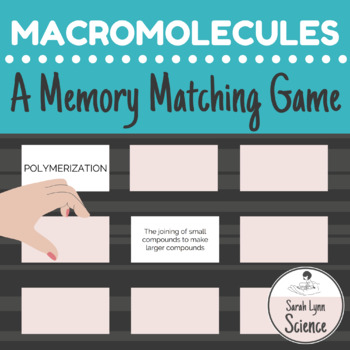- Zip
- Google Apps™
- Easel Activity
- Easel Assessment

Description
This macromolecule review activity promotes content retention using a classic memory card game! With biochemistry key terms included for both chemical reactions and biomolecules (carbohydrates, lipids, nucleic acids, and proteins), this editable macromolecules activity provides fun vocabulary practice for high school Biology and Honors Biology students!
Who Is This Product For?
Macromolecule Match is appropriate for both standard- and Honors-track Biology students.
What Is Memory and What Is Included in This Product?
Memory is a classic card game that requires players to rely on their short-term memories. The game uses a set of cards in which each individual card is part of a matching pair. In the set included in this resource, cards are divided into key terms and definitions. Students begin the game with all cards facing down, then flip the cards over two at a time in attempts to match each macromolecules vocabulary word with its corresponding definition. The game is over when all cards have been correctly paired.
Major topics and key words included on the cards are as follows:
- Chemical Reactions
- Carbon
- Polymerization, dehydration synthesis, monomer, polymer, hydrolysis reaction
- Activation energy, catalyst, endothermic reactions, exothermic reactions
- Carbohydrates
- Monosaccharides, disaccharides, polysaccharides
- Glucose, sucrose, starch, glycogen, cellulose, chitin
- Lipids
- Amphipathic, hydrophobic, hydrophilic
- Saturated, unsaturated, polysaturated
- Fats (triglycerides), phospholipids, steroids
- Nucleic Acids
- Nucleotide
- DNA, RNA
- Proteins
- Amino acids, R group, peptide bond
- Primary, secondary, tertiary, quaternary structures
- Enzyme, substrate, enzyme-substrate complex, active site
- Lock and Key model, denaturation
Additionally, the following key words are included at the end of the list for Honors classes:
- Alpha helix, beta pleated sheet
- Anabolic reaction, catabolic reaction, reaction coupling
- Ribozyme, cofactor, cofactor
- Sucrase, protease, lipase, DNA polymerase, pepsin
- Antagonist, allosteric site, allosteric inhibitor, allosteric activator
- Competitive, irreversible inhibition, and allosteric inhibition
- Negative feedback loop, positive feedback loop, metabolic pathway
Included in Your Purchase:
- Macromolecules Vocabulary Cards for memory game in PDF, Word (editable), and Google Doc (editable) formats
- Digital access to EASEL version of Macromolecule Match
- Digital access to EASEL multiple-choice questions
- Teacher Notes to aid in implementation
- Font Information sheet
- Terms of Use Agreement
When & Where Should This Product Be Used?
Students should complete this activity after they have received lessons or completed reading on the chemistry of life.
Product Details:
- Grade Levels: 9th-12th
- Possible Courses: Biology, Honors Biology
- Standards Alignment:
- NGSS Core Idea LS1.C
- Arizona State Science Standards HS.L2U1.21
- Mode of Learning: In-person or Online
- License Agreement: Single classroom use by original purchaser
Why & How Should This Product Be Used?
Are you looking for a quick and easy biology vocabulary activity for your macromolecules unit? Do you need a reusable resource that can be adapted for future classes? Are you trying to teach your students useful study skills that they can use at home? If you answered yes to any of these questions, then the Macromolecule Match is for you!
Here are some things that make this product amazing!
- Versatility: The editable features of this activity make it adaptable to students in different grade levels and courses.
- Engagement: Students love the simple but effective nature of this task, as well as the fact that it can be done either individually or collaboratively. They may even compete with each other to complete it the fastest!
- Formative Assessment: Determine which pieces of content students struggle with as they work, and use that information to get them up to speed before implementing your summative assessments.
Some potential uses for this resource include:
- Practice! Students can apply and practice their new biochemistry vocabulary while playing the game.
- Scaffold! Use the cards to create a word wall that students can refer to in class throughout the unit.
- Review! Have students use the biology memory game to reinforce their content knowledge at the end of the unit.
So, what are you waiting for? Let this vocabulary activity work for you!
Tips & Tricks:
Want to earn TpT credits that you can use to get free products? All you have to do is rate and review your purchases! Details about how this program works can be found here.
If you like this product, remember to follow me and get exclusive updates! Not only will this keep you in the loop, it’ll also provide support to me and my store, allowing me to continue creating awesome products for your classroom. Thank you for your support!
Happy teaching,
Sarah Lynn Science



